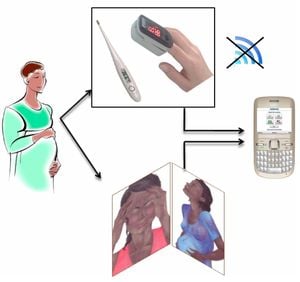
Problem being addressed[edit | edit source]
Almost 99% of global maternal deaths occur in developing countries. Pregnancy complications caused by time delays associated with slow symptom recognition and the patient referral process are some of the main reasons for maternal mortality in resource-limited settings and rural regions.
Detailed description of the solution[edit | edit source]
The proposed platform, which targets health care workers with minimal training level, operates based on three components: A pictorial booklet of pregnancy related complications, a set of hardware to measure vital signs, and a decision making and referral algorithm programmed in a cell phone. A culturally appropriate pictorial booklet of pregnancy related complications designed to assist the patient to identify complications and problems she faces, and a decision making algorithm generated by considering common complications and causes of difficulties during pregnancy is programmed in the health workers' cell phones. Once the patient presents any pregnancy-related complication to the health worker, her vital signs are measured automatically by the designed hardware and the results are sent to the cell phone through a Bluetooth device. Then, the health care worker asks a series of questions from the pregnant woman based on the prompts from the programmed algorithm in the cell phone. When all the data is inserted, the algorithm, in the form of the cell phone application, suggests actions, varying from immediate referral to district hospital to other possible steps, such as special medication or treatment, to take to address the complication.
Designed by[edit | edit source]
Lab for Innovation in Global Health Technologies - University of Michigan, Ann Arbor.
When and where it was tested/implemented[edit | edit source]
Preliminary fieldwork to evaluate the cultural appropriateness of the pictorial platform was performed in Ghana during summer of 2010. Further referral analysis and platform usability will be performed in Ghana during summer 2012.
References[edit | edit source]
Peer-reviewed publication[edit | edit source]
The project was presented during Design of Medical Devices Conference in Minneapolis (2012) as part of the "International Design Showcase".